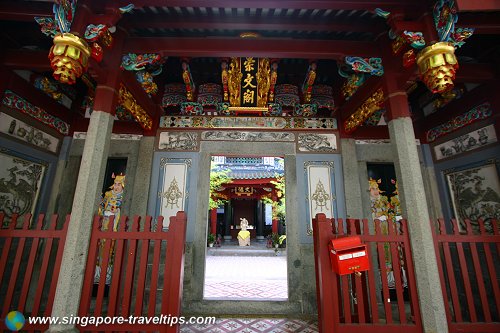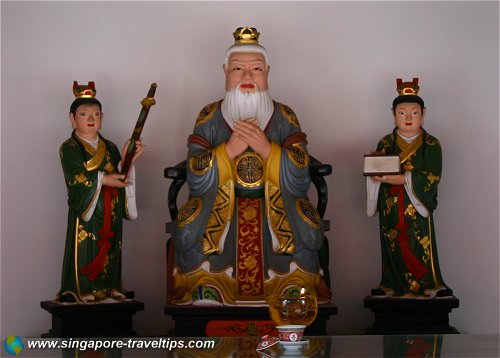 Thian Hock Keng Temple, Singapore (1 August 2017)
Thian Hock Keng Temple, Singapore (1 August 2017)
Thian Hock Keng Temple (GPS: 1.28093, 103.84763) is the oldest and grandest Hokkien Chinese temple within the Chinatown of Singapore. It is located along Telok Ayer Street, a curved street to the west of the Financial District of Singapore. The temple is located on the west side of Telok Ayer Street. It faces what used to be the coastline, which reached right up to Telok Ayer Street in the 19th century.
Thian Hock Keng Temple was built by the Chinese local leaders, Tan Tock Seng and Si Hoo Keh. They are Hokkiens who have moved to Singapore from Malacca. The temple was founded not only as a place of worship, but also at the meeting place for other Chinese people of the Hokkien clan. It also served as the clan association.
Thian Hock Keng Temple was dedicated to the goddess Matsu, also known at Ma Cho Po. Matsu is the patron deity of sailors and seafarers, and are worshipped by the Hokkiens in thanksgiving for safe passages. She was especially popular among the Hokkiens in southern China whose livelihood depended much on the sea and on fishing.

Main shrine of the Thian Hock Keng Temple (8 July 2006)


Side compound of the Thian Hock Keng Temple (8 July 2006)

What began as a small shrine is today one of the biggest temples in Singapore. The temple plan is almost symmetrical in design. Upon entering the ornate front entrance, you face the main prayer hall. On either sides of the main prayer hall are walled arcades.
Within the main prayer hall is the image of the goddess Matsu, flanked on either sides by her ladies-in-waiting. To her left (that means, on her right) is Bo Sheng Da Di, a physician who was immortalized as a deity, and worshipped as a god of good health. To her right is Guan Gong, a warrior deity with reddish face and long, black beard. He was a warrior named Guan Yu (AD220-AD280) who was immortalized as a deity and worshipped as a god of protection.
We now make an anti-clockwise circuit around the main hall. To the right of the main prayer hall is an arcade with smaller shrines. The first is a shrine to Qie Lan Pu San, also known as the Bodhisattva Sangharama. The next shrine is that of Confucius, an official and philosopher during the Lu Kingdom, now also worshipped by the Taoists.
 Image of Boddhisattva Avalokitesvara, or Multi-Limb Kuan Yin, at Thian Hock Keng Temple (8 July 2006)
Image of Boddhisattva Avalokitesvara, or Multi-Limb Kuan Yin, at Thian Hock Keng Temple (8 July 2006)
Along the arcade behind the main prayer hall are more shrines. Start from the right side, and working out way to the left, the first is to Tai Yang Gong, or the Sun Deity. This is another Bohisattva that acts as a protector deity. To the left of Tai Yang Gong is the Guan Yin, also known as the Avalokitesvara. This is the deity popularly known as the Goddess of Mercy. She is shown here with eight pairs of arms. To the left of the Goddess of Mercy is Yue Gong Ninag Ning, or the Moon Goddess. She is a maiden who ascended to the moon as a goddess. She is often worshipped by girls looking to find a good husband.
Now we explore the shrines on the arcade to the left of the main prayer hall. Starting with the shrine at the back and working our way to the front, the first shrine is that to Kai Zhang Seng, or the Sacred Governor Kai Zhang. Again, this is a mortal who was immortalized and worshipped. In the next shrine, we find the City God, or Cheng Huang Ye. The City Gpd also acts as the deity of the underworld. He is featured with his Two Great Generals, Qi Ye and Ba Ye. These two generals are tasked with escorting the departed criminals into hell.
As you return to the front entrance of Thian Hock Keng Temple, stand right in front of the main entrance and look out into the street. I want to show you how much Singapore has changed since the time the temple was built. It began as a small shrine in 1821. A proper temple was only put up in 1839, with wealthy patrons such as Tan Tock Seng gave generously to its expansion.
At the time that Thian Hock Keng Temple was first built, the coast line reached right up to Telok Ayer Street. That is how the street got its name, which means "watery bay". Over the years, land reclamation has extended the coastline outwards. On the reclaimed land is where the Central Business District of Singapore is located today, and even now a New Downtown is taking share on newly reclaimed land, and the coastline is pushed farther outwards.
How to reach Thian Hock Keng Temple
Take the East-West Line to the Tanjong Pagar MRT Station (EW15). From there, walk east along Chong Guan Street, with Anson Building on your right. At the junction, turn left and walk north along Anson Road. Cross Maxwell Road and continue along Cecil Street. When you see a park on your left (Telok Ayer Park), turn left to Telok Ayer Street. Follow it until you arrive at Thian Hock Keng Temple on your left. Distance: 2250 feetContact
Thian Hock Keng Temple158 Telok Ayer Street
Singapore 068613
Tel: 6423 4616
Thian Hock Keng Temple is  on the Map of Telok Ayer, Singapore
on the Map of Telok Ayer, Singapore
Thian Hock Keng Temple is  on the Map of Chinese Temples in Singapore
on the Map of Chinese Temples in Singapore
 Entrance to the Thian Hock Keng Temple (8 July 2006)
Entrance to the Thian Hock Keng Temple (8 July 2006)
 Image of Boddhisattva Sangharama, Thian Hock Keng Temple (8 July 2006)
Image of Boddhisattva Sangharama, Thian Hock Keng Temple (8 July 2006)

Image of Confucius, Thian Hock Keng Temple (8 July 2006)


Image of Kai Zhang Sheng Wang, or Sacred Governor Kai Zhang, at Thian Hock Keng Temple (8 July 2006)


Image of Cheng Huang (City Gods), Thian Hock Keng Temple (8 July 2006)


Door gods, Thian Hock Keng Temple (8 July 2006)

List of the Chinese Temples in Singapore; Discover Singapore
 Copyright © 2003-2025 Timothy Tye. All Rights Reserved.
Copyright © 2003-2025 Timothy Tye. All Rights Reserved.
Copyright © 2003-2025 Timothy Tye. All Rights Reserved.

 Go Back
Go Back